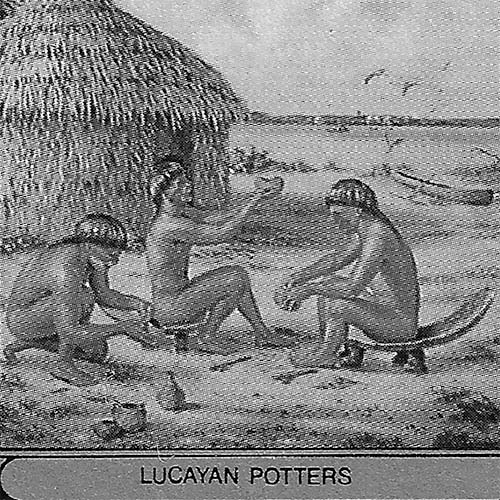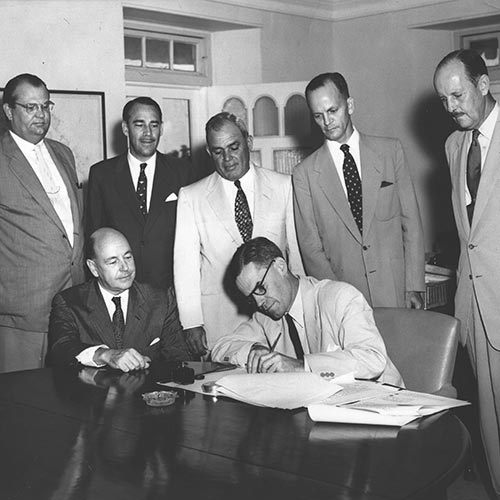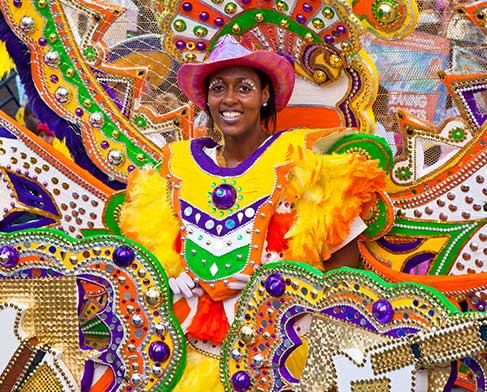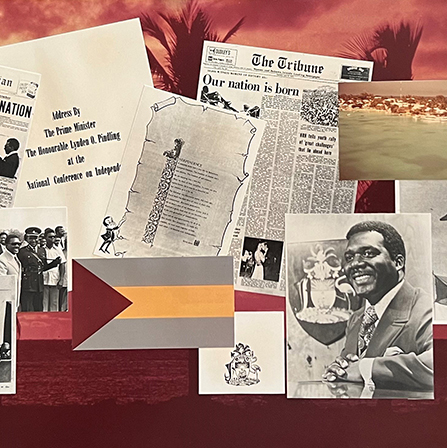History of the Port Authority
Commission Reports & Governmental Intervention
The Election is a Tie!
The January 10, 1967 election resulted in a surprising tie between the ruling United Bahamian Party and the Progressive Liberal Party opposition. Each party received 18 seats in the House of Assembly, with the two remaining going to Labour candidate Randol Fawkes and Independent Alvin Braynen.
The UBP and the PLP each approached Fawkes and Braynen for support, but both threw their support to the PLP, which was then able to form the new government. With the “radicals” now in charge, new fears over the status of Freeport arose, but Lynden O. Pindling, as Premier, said he had no intention of killing the goose that laid the golden eggs or of rescinding the Hawksbill Creek Agreement.
Pindling Wants Control
Pindling stated that his government intended to exercise more control over Grand Bahama, and the questions of “Bahamianization” - increased governmental control as well as more jobs and economic ownership for native Bahamians - and immigration were to be firmly addressed.
Following up on the Wall Street Journal’s exposé, Life magazine (Richard Oulahan and William Lambert, The Scandal in the Bahamas, Feb. 3, 1967) and the Saturday Evening Post (Bill Davidson, The Mafia: Shadow of Evil on an Island in the Sun, Feb. 25, 1967) published investigatory articles about the suborning of the Executive Council in securing the Certificate of Exemption and of the Mob’s influence in Freeport. This further excited the critics of the Grand Bahama Port Authority and Bay Street and handed the PLP prime election ammunition. Click here to read more - The Mafia: Shadow of Evil on an Island in the Sun by Bill Davidson - SE Post Feb 25, 1967 vol 204 issue 4 p. 27 - 37
New Investigations
On March 13, the “Commission of Inquiry into the Operations of the Business of Casinos in Freeport and in Nassau” commenced. The careful and painstaking process of hearings and analysis of documentary evidence resulted in the November 1967 report which essentially supported the more vivid accounts in the American media.
First, the crucial Certificate of Exemption had involved questionable payments to the members of the Executive Council (in the form of “consultancy fees” and other commissions):
- Premier Sir Roland Symonette was given $10,000 as a political donation in 1962, and later was to receive £6,000 a year for five years as a “consultant,” but he ended the agreement after 10 months and only received £5,000.
- Charles Trevor Kelly, Maritime Affairs Minister, received a subsidy for the use of his freighter, Betty K, for twice-weekly transport between Florida to Freeport (later a compensatory payment of $100,000 was substituted when the service proved impractical).
- Dr. Raymond Sawyer, a dentist and owner of Nassau’s Hobby Horse Hall racetrack, was offered £2,000 a year for five years as a medical consultant for Freeport.
- Capt. Frederic W. Brown, a pilot, received £2,500 for advising on pilotage in the Freeport channel.
- Sir Etienne Dupuch was given a personal donation of $10,000 in 1962 for his political campaign and $20,000 was given to his newspaper, the Nassau Tribune. He was later given a £500 a month fee, to a total of £12,000. His paper, which had seriously criticized the idea of gambling eventually became rather timid on the subject.
- Sir Stafford Sands received £200,000 for his work on the Certificate. In addition, he was given a retainer of £17,800 ($50,000) a year for “advising on promotion” for 10 years as well as other fees, totaled over $1,800,000.
- Robert H. “Bobby” Symonette, Speaker of the House of Assembly as well as Sir Roland’s son received £25,000 to advise on marina construction received.
Since no conflict of interest laws exist in the Bahamas, no charges were brought. However, all but Sir Roland left government service, Sir Etienne Dupuch later moved to Florida and Sir Stafford Sands went into exile in Spain.
Syndicate Casino Involvement
Once John “Tex” McCrary disclosures hit the papers, the presence of Meyer Lansky’s associates and Lou Chesler’s connections, were revealed. American gambling criminals were shown to be in control of or working at the Monte Carlo casino, including:
- Frank Ritter, alias Red Reed - “credit manager”, Morris Schmerzler, alias Max Courtney “general manager”, and Charles Brudner, alias Charlie Brud ,“floor manager” were employed at $100 a day plus 30% of the net profits as “annual bonuses”
- George Sadlo - Lansky’s 80-year-old sidekick
- Dino Cellini - “craps supervisor” and casino management expert
- James Baker - “craps supervisor”
- Roy Bell - “craps supervisor”
- David Geiger - “craps supervisor”
- Howard Kamm
- Al Jacobs - “craps supervisor
- Anthony Tabasso
- Hyman Lazar “floor manager” after Max Courtney was deported
- Frank Farrel
- Ernie Braca
Dino Cellini, James Baker, David Geiger, Al Jacobs and Roy Bell were deported from the Bahamas in March 1964. Frank Ritter, Max Courtney, and Charles Brudner lasted until 1967. In January of that year they made a deal with the casino in which they “leased” their files on the “credit-worthiness” of known American “high-rollers”—an important factor in a business where most losses were handled on credit rather than cash—to Bahamas Amusement, Ltd. for $2,100,000, to be paid over a 10-year period!
Although the Bahamas Amusement Ltd. administrators paid for the “lease” of the files, the Commission understandably found this excessive.
A New Casino Tax
In June, the new PLP led government voted to levy a tax of a million dollars a year on Freeport’s casinos. The Monte Carlo casino promptly closed in favor of the new El Casino, with the explanation that the company was not yet ready for such a financial burden.
In the end, the Syndicate seems to have either departed or become subdued enough that no further charges were made after the “clean-up” of fiscal and managerial irregularities suggested by the Royal Commission.
Gambling on Paradise Island
A secondary development involving Bahamas Amusements, Ltd. involved the introduction of gambling to Paradise Island, across the harbor from Nassau.
The island, formerly “Hog Island”—from the common colonial expedient of setting an island or a fenced-off peninsula where the community’s swine could be allowed to forage without endangering crops, had belonged to the wealthy Swedish Electrolux billionaire, Axel Wenner-Gren. In 1960, he sold it to A&P heir Huntington Hartford for $14 million.
In 1963 Hartford unsuccessfully tried to secure a gaming concession for his resort, but made the mistake of not going to the right lawyer – Sir Stafford Sands. He had also contributed to the new PLP, which was not the way to make friends among the Bay Street Boys.
A new initiative by Bahamas Amusements, Ltd. and the incongruous Mary Carter Paint Company bought the old Bahamian Club in Nassau in 1965. On August 17, 1966, they received a Certificate of Exemption for a new Paradise Island casino. There were conditions attached, such as the building of a bridge from New Providence Island by April 1, 1967 and the construction of a 500-room hotel by the end of that year.
As Bahamas Amusements, Ltd. was the primary legal gaming concession in the Bahamas, it made sense for them to be involved with the new venture. However, the 1966 scandal of Bahamas Amusements’ dubious connections with the Syndicate and the Bahamian Government caused them to divest the Paradise Island stock in March 1967. Apparently alarmed by the Freeport casino scandal, Mary Carter Paint bought out Wallace Groves’ interest and eventually cheated Hartford out of both his purchase price and his remaining shares. Click here to read more - Las Vegas East - Wall Street Journal - October 5, 1966
The Mary Carter Paint Company
Mary Carter Paint was incorporated in 1958, involving paint companies dating back to 1908, and retailed paint in Florida, the Bahamas and elsewhere.
President Jack Davis and CEO James Crosby bought out Bahamas Developers, Ltd. on Grand Bahama in 1962 and, hearing about the troubles Huntington Hartford was having on Paradise Island in 1964, decided to enter the profitable gaming and resort field.
At Sir Stafford Sands’ suggestion, they joined with Bahamas Amusements in early 1966. The partners opened the Bahamas’ third major casino in December 1967. Mary Carter Paint also acquired the Queen’s Cove property in Freeport from Daniel Ludwig, who, at the time, was developing his Princess Resort at Xanadu Beach.
In May 1968, Mary Carter Paint sold its paint division to Delafield Industries for just over $10 million and became Resorts International NV (based in the Netherlands). The new corporation acquired additional amusement companies in America, and bought the Bahamian company, Chalk's International Airline, Inc., in April 1974.
After Wallace Groves retired, his successors shifted the management of El Casino to Resorts International and the old Monte Carlo casino was resurrected as the Lucayan Beach Hotel and Casino. Resorts International was also successful in introducing gambling to Atlantic City in 1976.
Other Gambling Enthusiast Interest
There were also other would-be gambling enthusiasts chasing the golden certificates of exemption at the time.
Michael J. McLaney, an associate of Lou Chesler and former operator of the Hotel Nacionale casino in Havana (which he bought from the Syndicate three months before it was seized by Fidel Castro) had managed the Cat Cay Casino in Bimini for Louis Wasey’s daughter, Jane, in 1963-64.
In 1966 he approached Lynden Pindling with an offer to help him in the upcoming election. He supplied Pindling with a helicopter to take him to his constituency in Kemp’s Bay, Andros for eight or nine days; a Cessna aircraft to take him to various Out Islands for seven to ten days, and a DC-3 plane for two or three days.
McLaney also supplied Pindling with the services of a financial consultant from New York named Colasurdo, who initiated some complicated business dealings with the future Prime Minister involving a blueberry plantation and $1.9 million. There was no actual deal involved, but McLaney estimated that the combined contributions amounted to about $60,000.
McLaney also rented 13 rooms on the fourth floor of the Trade Winds building on Bay Street that he made available to members of the PLP, including Arthur Foulkes and James Shepherd. McLaney ended up with no return for his investment, but Lynden Pindling had gotten a tempting taste of what political power could attract. Click here to read more - The Scandal in the Bahamas - Life Magazine - February 3, 1967 pp. (58) 60 – 74
Nationalize/“Bahamanize” the Grand Bahama Port Authority?
While the Commission inquiries were ongoing, Wallace Groves and the Grand Bahama Port Authority were struggling with their public relations debacle and the potential changes in the Bahamian power structure.
They worried that the PLP controlled government might abrogate the Hawksbill Creek Agreement and even nationalize or “Bahamanize” the Grand Bahama Port Authority, which was a private corporation with no influential connections outside of the Bahamas.
As a hedge against such a move, they embarked on a complicated maneuver to get GBPA stock publicly traded on the New York Stock Exchange, apparently hoping to make a straight power grab less likely. They converted 92.5% of the GBPA stock to that of an American-controlled Philippines gold mining company—Benguet Consolidated.
The Philippines?
There were several good reasons for the involvement of a Philippines corporation. First, 97.5% of Benguet Consolidated stock was actually owned by American investors, the largest amount owned by Charles Allen’s brother and partner, Herbert. Second, Benguet Consolidated was facing a threat similar to that of the Grand Bahama Port Authority. The new Philippines’ constitution mandated that by 1974 a majority of the stockholders be Filipino citizens. Dictator Ferdinand Marcos had imposed legislation restricting foreign ownership of the country's mining companies to just 40 percent, and by 1971 Benjamin Romualdez, Imelda Marcos’s brother, had effective control of the company.
As the Report of the Royal Commission … to Review the Hawksbill Creek Agreement (1971) observed:
“It would therefore be to their advantage if [Benguet Consolidated] could amalgamate with another corporate entity and thus be enabled by the due date to ‘spin off’ assets other than its natural resources properties in the Philippine Islands and so secure their long-term interests.”
- Report of the Royal Commission, 197, p. 46
The Government Becomes a GBPA Partner
The maneuver was successfully completed on May 15, 1968, despite some resistance by the PLP Government. To entice the Government to agree to further modifications to the Hawksbill Creek Agreement the GBPA allowed the Government to purchase 7.5% of the new stock at a discount to become a “partner” on the board of the GBPA.
The Bahamas Handbook published an article entitled “What’s this Business about Benguet?” It announced that “Benguet shareholders approved the acquisition of 2,010,000 Port Authority shares in exchange for 9,990,075 Benguet shares, a swap totaling some U.S. $150 million.”
Asset Reorganization
The reorganization involved Charles Hayward’s Variant Industries shares as well as those of the Charles Allen and Wallace Groves. Benguet Consolidated American investors were able to extract their holdings from the Philippines and placed the Bahamian assets in a new Panamanian holding company, Intercontinental Diversified (ICD), in early 1974. The remaining assets were bought up by Charles and Herbert Allen, who then had no further part in the Grand Bahama story.
Benquet itself was largely taken over by Marcos’ family and cronies, who also extracted some $329,439 from the investors for approval by the Philippines Government for that end of the deal. With its stock safely tucked away in Panama, ICD, now the owner of the GBPA, became an internationally traded company in its own right and beyond the reach of the PLP Government.
The Benguet venture had a significant downside as the conditions demanded by the Bahamian Government led to a serious conflict between the Port Authority and the PLP. In exchange for the necessary approval of the Government for the Benguet merger, the GBPA agreed in principle “…to the measures which the Government proposes to take for the good government and proper control of the Port Area…”
New Conflicts Arise
Conflicts arose over the standardization of immigrant and customs controls as well as approval from Nassau for further development and new business licenses.
While the Grand Bahama Port Authority might have agreed to new “controls” or “procedures,” licensees rightly saw this as an unwarranted surrender of the rights they had under the Hawksbill Creek Agreement.
New restrictions on employing foreign personnel were particularly unwelcome. Despite claims by the Government, there were not enough capable Bahamians to fill positions. Counsel for the Port Authority in Britain was of the opinion that if it could be shown that
- No “key, trained and/or skilled” personnel could be found in the Bahamas
- That foreign candidates were in fact actually “key, trained and/or skilled”
- Candidates were of good character
the Government had “no [legal] discretion to withhold permission to the employer, to bring in the personnel and the number so required.” [Report of the Royal Commission, p. 54].
Contrary to the Hawksbill Creek Agreement, the PLP Government insisted on exercising final control over the hiring of all foreigners. The protocol proved to be costly, inefficient, dilatory and arbitrary in practice. Work permits were limited to six months or a year which greatly hindered the recruitment of professionals.
When the Royal Commission investigated licensee complaints, they found them to be overwhelmingly true and “stopped the investigation because it became embarrassing to continue.” [Report of the Royal Commission, 1971:64].
The Government prepared a white paper in late 1968 suggesting that Freeport “was eminently suitable” for reorganization as a unit of local government, but the Hawksbill Creek Agreement still stood in the way.
Pindling's "Bend or Break" Speech
On July 26, 1969 Lynden Pindling gave his famous “bend or break” speech at the opening of the BORCO refinery on Grand Bahama. This speech sent a strong message of the Government’s intentions toward Freeport.
According to Michael Craton, it was a last-minute departure from a bland planned address and left little doubt about the PLP’s resolve to curb the independence that had enabled Freeport to prosper so dramatically in the mid-1960s.
"In this city, where, regrettably, almost anything goes, where, promisingly, some economic opportunities have come to Bahamians, Bahamians are nevertheless still the victims of an unbending social order, which, if it now refuses to bend, must be broken." [Craton 2002:167]
The Immigration (Special Provisions) Bill of 1970
Licensees of the Grand Bahama Port Authority found it difficult to manage their businesses, find suitable employees and afford newly tightened customs duties. The discovery that the GBPA had already “bent” in principle to the Government’s demands in order to secure approval for the Benguet merger further aggravated the situation.
The Licensees’ Division of the Freeport Chamber of Commerce, represented by its president, Peter Bannock, met with Premier Pindling and proposed a rather assertive compromise. The GBPA reluctantly yielded to the demands of the licensees and served notice to the Government that the issue should be put to arbitration, as specified in the Hawksbill Creek Agreement. The Government ignored the request for arbitration and passed an act, the Immigration (Special Provisions) Bill, 1970, that essentially nullified the clauses respecting immigration in the Hawksbill Creek Agreement.
The original agreement to work out such disputes through Port Authority - Government arbitration was ignored and the Government assumed sole control over all immigration.
Legal But Unethical
This example of governmental breach of faith, as the Royal Commission recognized, may have been strictly legal under the new 1968 constitution, but it was unethical and had far-reaching negative consequences, not only for Freeport but for the Bahamas.
Capital investment is notably fluid. No one was going to put money into Bahamian development if there was a chance the Government might interfere and make it impossible to proceed or profit. Foreign investors took one look at the PLP move and shied away.
“Capital is so sensitive that it will not tarry to find out who is in the right legally or who is in the wrong.”
From Report of the Royal Commission, 1971, p. 66
Wallace Groves was disgusted by the short-sightedness of the PLP Government, wondering why it should “stupidly wish to destroy a city that was furnishing approximately one-fifth of their governmental revenues.” [Block 1998: 97]
Belief in Government Responsibility
To the Government this appeared to be a matter of national pride and an assertion of its perceived rights in the aftermath of the struggle with the Bay Street elite.
New challenges, such as another Royal Commission appointed in 1970 to review the Hawksbill Creek Agreement, would follow.
“When the U.S. Economy Sneezes, The Bahamas’ Catches Cold.”
To further complicate matters, the long postwar economic boom that had enabled Freeport’s growth came to an end. British sterling was devalued in November 1967, followed by the French franc in 1969. In 1971 the U.S. dollar ceased to be convertible into gold.
In Grand Bahama, the boom reached its height in 1968, but then leveled off. The U.S. went into a recession in mid-1969, and as has often been observed, “when the U.S. economy sneezes, the Bahamas’ catches cold.”
No substantial new projects were begun after July 1969, and an exodus from Grand Bahama to more promising places for investment took place.










